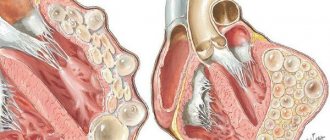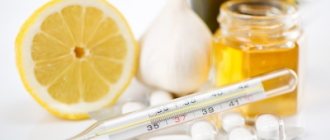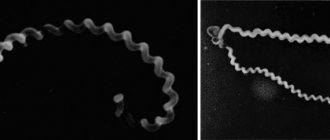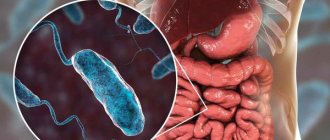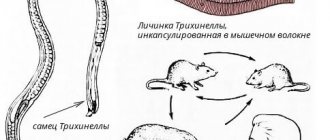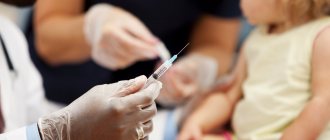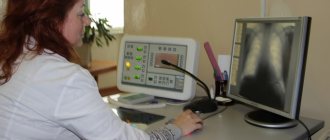Complexes with this research
Men's check-up No. 1 39 studies for an annual preventive examination 18,570 ₽ Composition
Women's check-up No. 1 38 studies for an annual preventive examination 19,290 ₽ Composition
Risk of severe COVID-19 Diagnosis of prediabetes and bleeding disorders RUB 1,090 Composition
IN OTHER COMPLEXES
- Extended coagulogram RUB 4,150
- Examination during pregnancy. 1st trimester 16,690 RUR
- Expanded hospital complex RUB 7,700
- Preventative check-up RUB 11,960
- Coagulogram RUB 2,020
Foodborne illnesses
Food poisoning is caused by a large group of bacteria ; the main pathogens are Staphylococcus aureus, Proteus vulgaris, Bacillus cereus, Clostridium perfringens, Clostridium difficile, representatives of the genera Klebsiella, Enterobacter, Citrobacter, Serratia, Enterococcus, etc. The pathogens are widespread in nature, have pronounced resistance and are able to reproduce in environmental objects. All of them are permanent representatives of the normal intestinal microflora of humans and animals. Often, it is not possible to isolate the pathogen from sick people, since the clinical picture of foodborne toxic infections is mainly determined by the action of microbial toxic substances. Under the influence of various environmental factors, opportunistic microorganisms change biological properties such as virulence and resistance to antibacterial drugs. Epidemiology The source of infection is various animals and people. Most often these are persons suffering from purulent diseases (felons, tonsillitis, furunculosis, etc.); Among the animals there are cows and sheep suffering from mastitis. All of them secrete pathogens (usually staphylococci) that enter food products during processing, where bacteria multiply and accumulate. Both patients and carriers of pathogens pose an epidemiological danger. The infectious period of patients is short; Regarding the timing of bacterial carriage, the data are contradictory.
The causative agents of other toxic infections (C. perfringens, B. cereus, etc.) are released by people and animals into the external environment with feces. The reservoir of a number of pathogens can be soil, water and other environmental objects contaminated with animal and human excrement.
The transmission mechanism is fecal-oral, the main route of transmission is food. For foodborne toxic infections caused by opportunistic bacteria to occur, a massive dose of the pathogen or a certain amount of time is required for its reproduction in food products. Most often, foodborne toxic infections are associated with contamination of milk, dairy products, canned fish in oil, meat, fish and vegetable dishes, as well as confectionery products containing cream (cakes, pastries). The main product involved in the transmission of clostridia is meat (beef, pork, chicken, etc.). The preparation of certain meat dishes and products (slow cooling, repeated heating, etc.), the conditions for their sale, contribute to the germination of spores and the proliferation of vegetative forms. Various environmental objects participate in the relay race of the pathogen: water, soil, plants, household items and patient care items. Products containing staphylococcal and other enterotoxins do not differ from benign ones in appearance, smell and taste. Diseases occur in the form of sporadic cases and outbreaks. They are more often recorded in the warm season, when favorable conditions are created for the proliferation of pathogens and the accumulation of their toxins.
People's natural sensitivity is high. Usually, most people who eat contaminated food get sick. In addition to the properties of the pathogen (sufficient dose, high virulence), the development of the disease requires a number of contributing factors from both the microorganism and the macroorganism (reduced resistance, the presence of concomitant diseases, etc.). Individuals at risk are more susceptible: newborns, weakened individuals, patients after surgery or those who have been receiving antibiotics for a long time, etc.
Basic epidemiological signs. Diseases caused by opportunistic microorganisms are widespread. Outbreaks are familial in nature or when food is contaminated in catering establishments, diseases can be dispersed throughout the population. The number of cases determines the number of people who consumed the contaminated food product and can vary significantly. In particular, group diseases are very common among passengers of sea vessels, tourists and members of children's and adult organized groups. Outbreaks are usually explosive in nature. No differences in socio-age or gender composition were identified. Diseases are more often recorded in the summer. Depending on the type of food product, children or adults predominate among the sick. In addition to food outbreaks, household outbreaks are also possible, in most cases occurring in hospital settings. Outbreaks of nosocomial infections caused by C. difficile are associated with long-term use of antibiotics. During water outbreaks as a result of fecal contamination, other pathogens of acute intestinal infections are also released along with opportunistic microorganisms.
Detailed description of the study
Normal blood clotting is possible by maintaining a balance between the processes of blood clot formation and mechanisms that prevent excessive blood clotting.
Prothrombin is a protein that is produced in the liver and plays an important role in blood clotting. Under its action, blood clots form in case of damage to the vascular wall, and bleeding stops.
Prothrombin time (PTT) is the time in seconds it takes for a blood clot, or thrombus, to form.
Prothrombin index (PTI) is a value equal to the ratio of the PTI of the control sample to the PTI of the test sample, expressed as a percentage. The indicator is also used in conjunction with other tests included in the coagulogram to assess the risk of thrombosis or bleeding.
INR (international normalized ratio) is a calculated value characterizing the ratio of prothrombin time and prothrombin index. This indicator is used to monitor treatment with indirect anticoagulants. These drugs reduce the body's ability to form blood clots by blocking the formation of clotting factors. Patients taking anticoagulants should regularly monitor this indicator to prevent complications of anticoagulant therapy. The frequency of INR testing is determined by the attending physician.
Cardiovascular diseases, liver pathology, diabetes mellitus and some other conditions contribute to an imbalance between the blood coagulation and anticoagulation systems. During pregnancy, there is also some change in PTT, PTI and INR. It is caused by changes in hormonal regulation and related factors and usually refers to physiological conditions.
An increase in PTT may be associated with bleeding, and its reduction increases the risk of thrombosis. To prevent complications associated with thrombosis, drugs are prescribed that reduce the likelihood of vascular clot formation - anticoagulants. At the same time, these medications, if the dose is incorrectly selected, increase the risk of bleeding, which requires specialist supervision.
The results of the analysis reflect the value of all three indicators. Assessment of PTT, PTI and INR will help the doctor assess the state of the blood coagulation system and select treatment.
Publications in the media
Foodborne illnesses are acute infectious diseases caused by opportunistic bacteria that produce exotoxins. When microorganisms get into food products, toxins accumulate in them and can cause human poisoning.
Etiology • Foodborne illnesses (FTIs) are caused by a large group of bacteria; the main pathogens are Staphylococcus aureus, Proteus vulgaris, Bacillus cereus, Clostridium perfringens, Clostridium difficile, representatives of the genera Klebsiella, Enterobacter, Citrobacter, Serratia, Enterococcus, etc. • Pathogens are widespread in nature, have pronounced resistance and are able to reproduce in environmental objects. All of them are permanent representatives of the normal intestinal microflora of humans and animals • Often it is not possible to isolate the pathogen from sick people, because The IPT clinic is mainly determined by the action of microbial toxic substances • Under the influence of various environmental factors, opportunistic microorganisms change their biological properties such as virulence and resistance to antibacterial drugs.
Epidemiology.
• The source of infection is various animals and people •• Most often these are persons suffering from purulent diseases (felons, tonsillitis, furunculosis, etc.); Among the animals there are cows and sheep suffering from mastitis. All of them secrete pathogens that enter food products during their processing, where the reproduction and accumulation of pathogens occurs •• Both patients and carriers of pathogens pose an epidemiological danger •• The period of contagiousness of patients is short, data are contradictory regarding the timing of bacterial carriage •• Pathogens of other toxic infections (C. perfringens, B. cereus, etc.) are excreted by people and animals into the external environment with feces •• The reservoir for a number of pathogens can be soil, water and other environmental objects contaminated with animal and human feces.
• Transmission mechanism - fecal-oral; the main route of transmission is food • For the occurrence of PTI caused by opportunistic bacteria, a massive dose of pathogens is required or a certain time for its reproduction in food products •• Most often, PTI is associated with the contamination of milk, dairy products, canned fish in oil, meat, fish and vegetable dishes, as well as confectionery products containing cream (cakes, pastries) •• The main products involved in the transmission of clostridia are meat (beef, pork, chicken, etc.) •• Preparation of some meat dishes and products (slow cooling, repeated heating, etc.), the conditions for their implementation contribute to the germination of spores and the proliferation of vegetative forms • Various environmental objects participate in the relay transmission of the pathogen: water, soil, plants, household items and patient care • Products containing staphylococcal and other enterotoxins, according to appearance, smell and taste do not differ from benign • Diseases occur in the form of sporadic cases and outbreaks. They are more often recorded in the warm season, when favorable conditions are created for the proliferation of pathogens and the accumulation of their toxins.
• People's natural sensitivity is high. Usually, most people who have consumed contaminated food fall ill • In addition to the properties of the pathogen (sufficient dose, high virulence), for the development of the disease, factors that contribute to the occurrence of PTI are necessary, both from the microorganism and from the macroorganism (reduced resistance, the presence of concomitant diseases, etc. .) •• People from risk groups are more susceptible: newborns, weakened individuals, patients after surgical interventions or who have been receiving antibiotics for a long time, etc.
Pathogenesis . A common property of all PTI pathogens is the ability to synthesize various types of exotoxins (enterotoxins) and endotoxins (lipopolysaccharide complexes). It is precisely because of the peculiarities of the action of these toxins that a certain uniqueness is noted in the clinical manifestations of PTI caused by various pathogens. The extremely important role of bacterial toxins in the development of PTI is also indicated by the relatively short incubation period of the disease.
• Depending on the types of toxins, they can cause hypersecretion of fluid into the intestinal lumen, clinical manifestations of gastroenteritis and systemic manifestations of the disease in the form of intoxication syndrome.
• Bacterial toxins realize their effect through the synthesis of endogenous mediators (cAMP, Pg, IL, histamine, etc.), which directly regulate the structural and functional changes in organs and systems detected in patients with IPT.
• The similarity of the pathogenetic mechanisms of PTI of various etiologies determines the commonality of basic principles in approaches to therapeutic measures for these diseases, as well as for salmonellosis and campylobacteriosis.
Clinical picture • The incubation period is usually several hours, but in some cases it can be shortened to 30 minutes or extended to 24 hours or more • Despite the polyetiology of PTI, the main clinical manifestations of intoxication syndrome and water-electrolyte disorders in these diseases are similar to each other and are little distinguishable from those of salmonellosis • The disease is characterized by an acute onset with nausea, repeated vomiting, loose stools of an enteritic nature from several times to 10 or more bowel movements per day • Abdominal pain and temperature reaction may be minor, but in some cases severe cramping abdominal pain, short-term (up to a day) increase in body temperature to 38–39 ° C, chills, general weakness, malaise, headache • The severity of clinical manifestations of dehydration and demineralization depends on the volume of fluid lost by the patient during vomiting and diarrhea • Course The illness is short and in most cases lasts 1–3 days.
Differential diagnosis . PTI should be distinguished from salmonellosis and other acute intestinal infections - viral gastroenteritis, shigellosis, campylobacteriosis, cholera and others, as well as from chronic gastrointestinal diseases, surgical and gynecological pathologies, MI.
Laboratory diagnostics • The basis is the isolation of the pathogen from vomit, gastric lavage and feces • However, the pathogen is isolated quite rarely, and the detection of a specific microorganism in a patient does not yet allow it to be considered the cause of the disease. To do this, it is necessary to prove the etiological role of the pathogen either using serological reactions with an autostrain, or by establishing the identity of the pathogens isolated from the contaminated product and from the patient’s secretions.
Complications are recorded extremely rarely; hypovolemic shock, acute cardiovascular failure, sepsis, etc. are possible.
Treatment is the same as for salmonellosis • Gastric lavage, siphon enemas, early administration of enterosorbents (activated carbon, etc.), vitamins are indicated • If necessary, rehydration therapy is carried out (see Salmonellosis) • Etiotropic treatment for uncomplicated IPT is not indicated.
Abbreviations . PTI - food poisoning.
ICD-10 • A05 Other bacterial food poisonings
